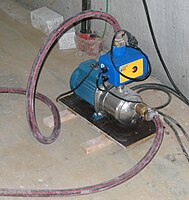
Photo from wikipedia
Correct energy management offers the best possibility for reducing the costs in agricultural production. In present day farming energy and agronomic efficiencies are both important factors. As the working-width of… Click to show full abstract
Correct energy management offers the best possibility for reducing the costs in agricultural production. In present day farming energy and agronomic efficiencies are both important factors. As the working-width of implements has increased, air-seeding is the best solution for the sowing of cereal crops. One of the problematic areas is the design of the air-delivery system, particularly if the pneumatic conveying system is wrongly dimensioned. The flow of seeding material during conveying must be high and regular enough for a high-speed seeding. There are three parameters that ensure the conveying of seeding material in a pipe: air velocity, flow concentration and pipe diameter. It is demonstrated that the outlets of the divider heads are the most critical part of the conveying system. Outlet pipes relatively small diameters and must allow for the highest seeding rates without clogging. It was hypothesised that the air velocity in outlet pipe may be used as an input data for designed a completed conveying system. This paper determines I) a minimal air velocity and flow concentration per type of seeds relative to pipe diameter; II) establishes a method to measure the air velocity of the loaded flow, which could be used to optimise existing seeders from an energy point of view; III) describes a global design methodology for air-seeder conveying systems; IV) reports an comparative study of energy of the most commonly used outlet pipe diameters within the air-seeders; V) describes a method for calculating the energy consumption evaluation; VI) prescribes the optimum outlet pipe diameter deduced from our experimental results, necessary for the design of the following divider heads. Tests were carried out using for wheat and barley seeds, starter fertilisers and a wheat–fertiliser mixture, for three currently used pipe diameters (20, 25 and 30 mm).
Journal Title: Biosystems Engineering
Year Published: 2018
Link to full text (if available)
Share on Social Media: Sign Up to like & get
recommendations!